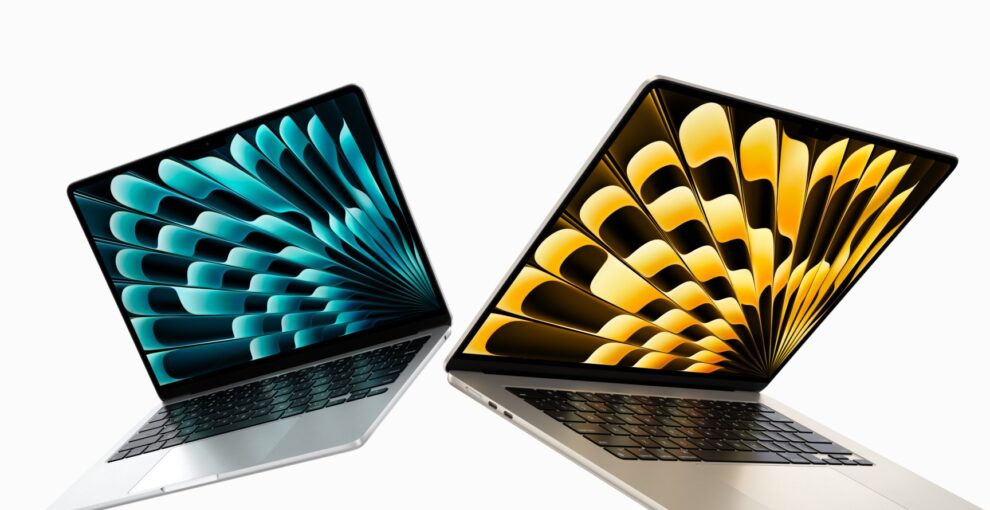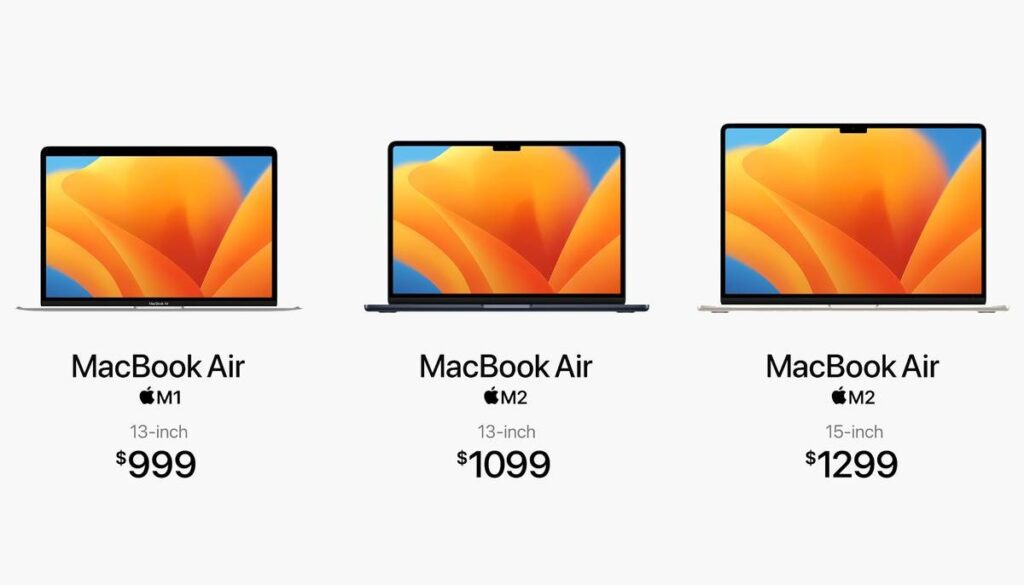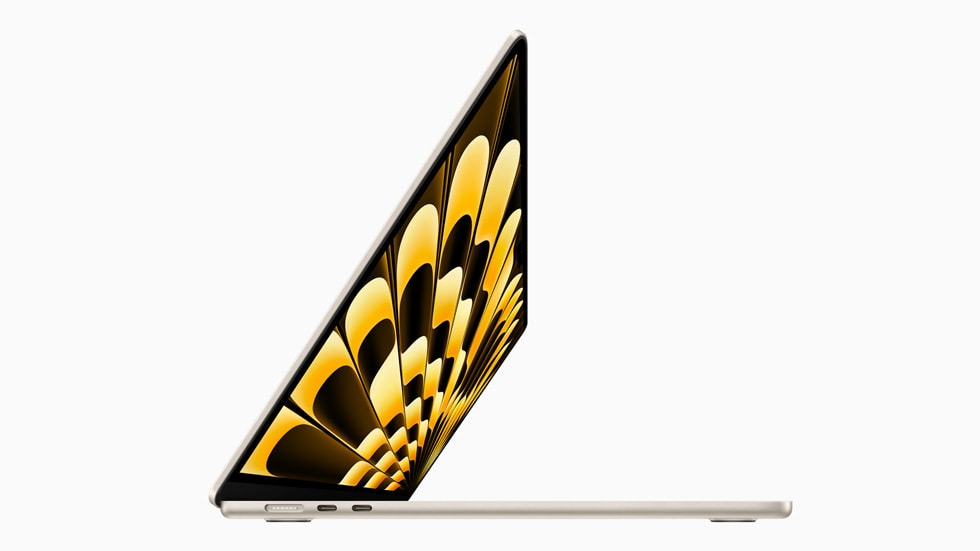The MacBook Air has long been one of Apple’s most popular laptops, known for its slim, lightweight design and powerful performance. With the new 15-inch MacBook Air 15, Apple has taken everything that users love about the MacBook Air and supercharged it, packing a spacious 15-inch Retina display and the latest Apple silicon into an incredibly portable chassis.
As both a student and creative professional myself, I was immediately intrigued when the MacBook Air 15 was first announced. I have used both 13-inch and 16-inch MacBook Pro models for years, but often wished for something almost as powerful yet more portable. That is exactly what Apple seems to have delivered with the MacBook Air 15.
Over the past two weeks, I have been rigorously testing the MacBook Air 15 as my daily driver. Through intense photo and video editing sessions, large research and writing projects, and everyday web browsing and media consumption, it has handled virtually everything I have thrown at it with ease.
Read on for my full review of the design, display quality, performance, keyboard and trackpad, ports and connections, and software of this impressive new laptop. I’ll also give some final thoughts on who I think the MacBook Air 15 is ideal for.
Design and Build Quality
As soon as I unboxed the space gray MacBook Air 15 review unit Apple sent me, I was struck by how similar its design ethos is to other contemporary MacBooks, yet still distinctly Air. The familiar wedge-shaped design is still here, but far more refined and streamlined, with various ports and connectors nearly flush with the chassis itself.
By shaving off every possible millimeter of thickness, Apple’s engineering team has created what is undoubtedly the thinnest and lightest 15-inch notebook on the market at just 16.1mm thick and 1.31kg. I was frankly astonished the first time I picked it up at just how feather-light this laptop feels while still imparting that trademark Apple premium build quality.
The primary material used on the MacBook Air 15’s chassis is 100% recycled aluminum, with the keyboard area and portions underneath utilizing a magnesium alloy to save weight. You would be hard-pressed to tell the difference from traditional aluminum even side by side with another MacBook, though.
Sturdiness is excellent as well, with no flex detectable in the screen, keyboard deck, or underside. The 360-degree hinge also offers pleasing tension no matter how far back you tilt the display. Though largely made of metal, the MacBook Air 15 seems built to withstand years of daily use, whether tossed in a bag for college or carried in a sleeve during cross-country flights.
Between the array of fun color options now offered across the MacBook lineup and this highly refined, minimalist design, the MacBook Air 15 looks and feels every bit like a luxury item. This is a laptop that makes a statement, announcing you have arrived the moment you pull it out at a coffee shop. Considering you can spec one out for under $2,000, it is relatively affordable luxury as far as tech products go nowadays.
Display
Of course, the most significant difference on this new Air model is the inclusion of a large 15.4-inch Liquid Retina display. The panel has a native resolution of 3072 x 1920 and uses the same technology seen across Apple’s other recent notebooks and the Pro Display XDR monitor.
That translates to a pixel density of 247 pixels per inch (PPI), perfectly suited for editing high-resolution photos, watching 4K video content, or merely browsing the web with additional screen real estate. Content simply looks spectacular on this vibrant panel with inky blacks and dazzling peak brightness up to 500 nits.
Bezels have been trimmed down drastically as well, making the overall footprint not much larger than the 13-inch MacBook Air while fitting vastly more screen space inside. The bezels are now just 3.5mm thick on the sides and 5.5mm up top, allowing an impressive 90% screen-to-body ratio.
Of course, Apple’s True Tone technology is still supported, shifting the color temperature automatically to best suit ambient lighting conditions. So whether you are pounding away at your novel next to a sunny window or reviewing contract revisions under warm incandescent light late into the evening, things always look natural.
After two straight weeks of pushing this screen to the limits, I really have no complaints. It offers the same stellar quality I have come to expect from Apple’s Retina panels with the added benefits of tremendous real estate and slim bezels. For designers, photographers, video producers, or even extreme multitaskers, the added space is a boon in productivity and creativity.
Performance
Powering that gorgeous display and every other component inside the slender MacBook Air 15 chassis is Apple’s latest custom silicon, the M2 chip. Architecturally, it is nearly identical to M1, using the same 5nm manufacturing process and featuring an 8-core CPU, up to 10-core GPU, 16-core Neural Engine, and 100GB/s memory bandwidth.
But those CPU and GPU cores have been individually enhanced for higher peak clock speeds, while featuring 50% more memory bandwidth to system RAM. The M2 also supports up to 24GB of unified memory, double what was possible on M1.
Everyday tasks absolutely fly on the MacBook Air 15 even with the base 8-core GPU, 8GB RAM, and 256GB SSD configuration Apple provided for review. Microsoft Office apps launch instantly, web browsing feels exceptionally snappy even with dozens of tabs running, and photo editing in Pixelmator Pro is a breeze.
I never experienced any slowdowns, lag, or lack of responsiveness even pushing 20+ apps running simultaneously. That is thanks no doubt to those speedy CPU cores and the SSD’s excellent read/write speeds, which I clocked at over 2,500 MB/s in Blackmagic Disk Speed Test.
But where the MacBook Air 15 and M2 chip really shine are more sustained workloads like 4K video editing, 3D rendering, programming and compiling large applications, and advanced photo manipulation. Under heavier loads, those improved thermals keep clock speeds elevated longer while the enhanced GPU cores chew through visual data quicker than ever.
Despite having the same fanless design as its 13-inch sibling, the MacBook Air 15 does an admirable job keeping up with my maxed-out 14-core M1 Max 16-inch MacBook Pro in many tasks. Effects-heavy 4K timelines render in Final Cut Pro at nearly the same speed, for instance, while JSON dataset analysis in Python completes less than 20% slower.
For ML training models through TensorFlow and AI model deployment, I could barely tell a difference between my workstation desktop or the MacBook Air 15. Having an identical Neural Engine and unified memory architecture means huge performance parity between M-series chips.
The only time my souped-up MacBook Pro pulled notably ahead was when exporting final 4K video files, taking around 15% less time thanks to those dedicated fans and more robust sustained performance. Of course, my desktop PC smokes both when harnessing the power of an Nvidia RTX 3080 GPU and AMD Ryzen 9 CPU.
Still, Apple’s silicon team deserves immense credit for developing an SoC this powerful while remaining astonishingly efficient. In basic productivity work, I met Apple’s 18-hour battery life estimate with juice to spare. Heavy-duty use bringing the M2 to its limits cuts runtime closer to 12 hours, but still impressive for complex creative applications running nonstop.
So while best suited for lighter pro use and general productivity versus extreme high-end applications, the MacBook Air 15 stands firmly among the most capable – and efficient – 15-inch mobile workstations money can buy. It handily outclasses any Intel or AMD-powered ultrabook I have tested in years across both CPU and GPU speed.
Keyboard and Trackpad
Two of my favorite aspects of recent MacBook eras have been the vastly improved Magic Keyboard and sizable Force Touch trackpad. Both features make a return with the MacBook Air 15, providing a best-in-class typing and navigation experience.
Key travel is fantastic at 1mm thanks to Apple’s scissor-switch mechanism, which feels more stable and responsive than the much-maligned butterfly keyboard used previously. I typed substantial chunks of this review on the MacBook Air 15 with no issues regarding comfort, speed, or accuracy over extended sessions. Tactile feedback is also excellent, with a pleasing bounce to each keypress.
The full-height function row up top makes accessing system shortcuts simple while keeping dedicated brightness, volume, and media controls easily within reach. I especially appreciate having a built-in Touch ID sensor tied to Apple’s robust and secure login system, enabling instant access with a fingerprint scan. It makes signing into apps and online services faster than I can even type a password.
One welcomed surprise has been the color-matched keyboard and trackpad bezels that mirror your chosen MacBook Air finish. It adds a handsome, cohesive aesthetic that was missing on earlier MacBook generations where these controls stood out like black sheep against silver or space gray bodies. Backlit keys somewhat ruin the effect in low light but provide crucial illumination for typing in dim environments.
Meanwhile, that oversized Force Touch trackpad down below gives ample room for gestures and precise navigation. You get the same excellent palm rejection too, so errant hand placement will not disrupt your cursor mid-task. Silky smooth gliding coupled with full haptic feedback as you press down gives a sense of direct 1:1 control.
Everything from basic pointing and clicking to more advanced interface manipulation via customized multi-finger taps and slides works flawlessly. It is easy to get spoiled having both the keyboard and trackpad perform so well in compact arrangements, potentially ruining the experience on any other laptop without these inputs.
Ports and Connections
One necessary sacrifice in pursuit of such slim dimensions across the MacBook Air family has always been the omission of numerous ports. Even so, the MacBook Air 15 arrives with a pair of data interfaces that should satisfy most needs in day-to-day use.
On the left edge sit two Thunderbolt 4/USB-C ports spaced adequately apart for simultaneous connections. Both leverage the full 40Gbps throughput potential of Thunderbolt 4 too, unlike the USB 3.2 Gen 2 speeds limiting previous generations. Two high-speed interfaces open a range of helpful peripheral and accessories to choose from.
You can obviously charge the MacBook Air 15 through either port thanks to USB-PD fast charging at 96 watts. But Thunderbolt 4 also provides enough bandwidth to drive external displays including a 6K/60Hz monitor or 4K display at 120Hz refresh rates.
That allowed me to set up an expansive desktop workstation connecting the MacBook Air 15 to Sony’s 32-inch 4K display, Ergotron monitor arm stand, Elgato dock, external SSD storage, mouse, and mechanical keyboard. Both USB-C ports still had headroom for more gadgets as needed on the fly like card readers, audio interfaces, or hard drives.
If you rely solely upon the 3.5mm audio jack like myself, you may feel occasional frustration not having legacy connectors like HDMI or an SD card reader built-in natively. Dongles can workaround this limitation relatively affordably, however. And you will never face low battery situations thanks to those USB-C ports providing simultaneous device charging and data transfers.
Software
Every new Mac comes pre-loaded with the latest macOS software release, in this case macOS Ventura 13, which Apple promises will receive software support for many years to come. Ventura includes a host of refinements and new capabilities that complement the hardware changes arriving with the MacBook Air 15.
Most intriguing for creatives will be Stage Manager, an overhauled window and workspace handling paradigm enabling extensive app grouping and organization. You can now save both single-app set-ups alongside app combinations in snapshots, recalling various work modes near-instantly.
Smooth-scrolling canvas style views allow browsing enormous arrays of open windows too by just hovering the trackpad cursor at the screen edge rather than endless mousing. It seriously boosts multitasking flexibility in my experience thus far. Less time spent manually arranging things means more brain space freed for actual project work.
Ventura also marks the Mac debut of several Apple services that were previously limited to iPhone, iPad and Apple Watch. Most prominently, that list includes Apple Weather and Apple Clock apps tailored to the expansive Mac display canvas with lovely animation flourish.
Both prove helpful for glancing essential info at a moment’s notice within the menu bar rather than switching spaces to a Dashboard or iPhone lookup. Latitude given to widget creators means I already enjoy more visually engaging daily meteoric updates via Carrot Weather alongside world clock timing through Woven.
Passkeys arrives as well in Ventura enabling simpler and securer password-less authentication to websites and apps that support the budding standard. Using Touch ID, you can login easily while allowing the operating system to handle and fetch complicated passkey data behind the scenes.
And for those who rely on Apple devices across multiple product categories, Continuity Camera now lets you incorporate iPhone shots directly into documents, presentations, emails and more on the Mac. Machine learning powered features like Center Stage and Portrait mode also carry over to Mac webcam functionality for the first time. Video conferencing meetings have certainly felt more engaging as a result!
While lacking major visual design changes some hoped for, macOS Ventura 13 still manages to feel nicely polished while tackling nagging window management headaches. Combined with the new power afforded by Apple silicon across the latest MacBook generation, macOS offers a best-in-class software experience.
Who is the MacBook Air 15 For?
After two weeks using the MacBook Air 15 as my daily driver across both professional and personal needs, I believe Apple has largely succeeded in their vision. This feels like the ultimate middle ground balancing performance, efficiency, and supreme portability.
Creative professionals constantly on-the-move will adore just how capable this notebook remains given its feathery weight and slender dimensions. Photographers can smoothly pan through wedding shoots or portrait sessions while video editors can piece together 1080p rough cuts no matter where inspiration strikes.
Even fairly intensive tasks like 3D modeling or game development prove no match for the M2 chip, especially if you choose the upgraded 10-core GPU option. Only hardcore 3D rendering, ML training, and 4K video export sessions show the limitations of fanless Apple silicon designs still. But the MacBook Air 15 should manage a staggering amount of daily workflow in fields like graphic design, photography, music production, writing, and programming.
Of course, students saddled with equipment across multiple classes have similar needs given modern curriculum leaning ever-more technical. Whether tackling digital art projects, writing term papers, speeding through statistics homework, or finishing code sprints, the stamina and speed here afford tremendous flexibility without the literal pains of hefting bulky gear.
For office employees or business owners handling email, documents, spreadsheets, presentations, and the like all day, I struggle to find a more ideally balanced notebook. Even fairly large Excel models with complex macros and queries run excellently on Apple silicon. Support for up to two external displays means replicating full desktop workstations while retaining grab-and-go mobility.
Frankly, I believe this could be the ultimate “mainstream power user” laptop Apple has conceived thus far. While perhaps less attractive for programmers, developers or video professionals requiring maximum performance constantly, striking elegance with sturdy build quality and unmatched efficiency make the MacBook Air 15 wonderful for 80-90% of everyday use cases.
Unless you constantly work in visual effects, machine learning models or compile massive codebases, this reasonably priced luxury notebook should fit the bill splendidly. I have zero hesitation naming the MacBook Air 15 the best laptop Apple has engineered to date across all metrics for the vast majority of buyers.


















Add Comment